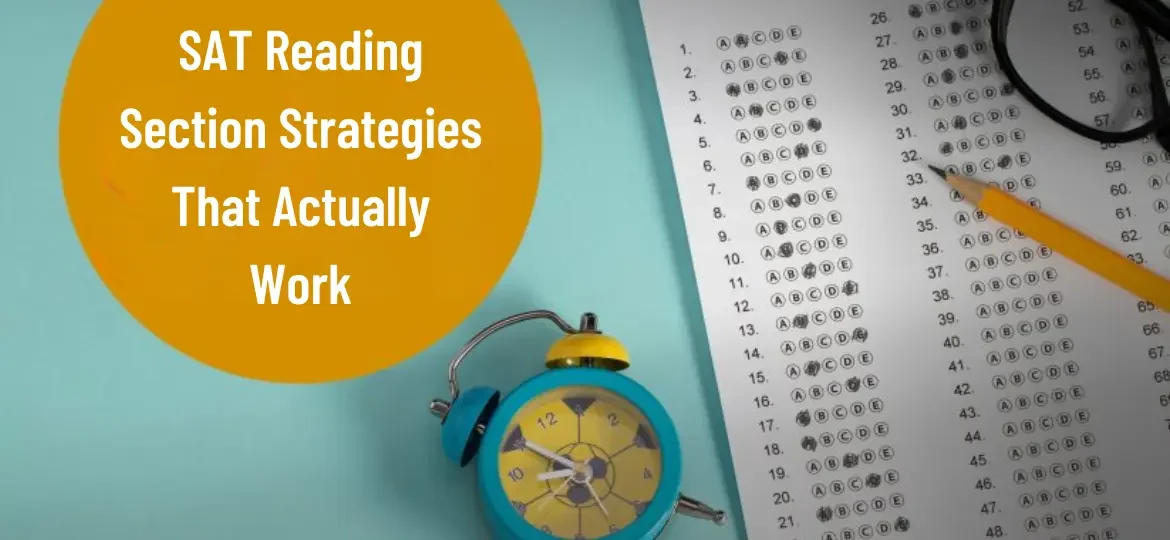


Overview of SAT Reading Section
Have you ever written the SAT test and realized that the reading section was quite complex for you? Oh well, it’s okay, you are not the only one! Understanding the SAT Reading Section is one section that many students find challenging, but there are many tips you ought to follow. In this particular blog, more emphasis is placed on the SAT reading section, strategies on how to work on it and fun activities to engage in. Here, we have to do all we can to make SAT reading as easy and enjoyable as possible!SAT Reading Section – Explained
Well, we have come to know everything about the SAT Reading Section let us go straight into the techniques of the SAT reading. This section checks your ability to read and analyze passages from various fields of study such as literature, history, social sciences, and natural sciences. You should be prepared to answer questions covering issues like the nature of the author’s main thought, his/her conclusions and their implications, as well as, the author’s attitude.Why Do You Need SAT Reading Strategies?
The Importance of Good Strategies for Your SAT Reading Section:- They help you spend your time more productively.
- They improve your comprehension capabilities.
- They help you answer questions more accurately.
- They contribute to your overall SAT score.
- Get to Know the Test Format
- Passages: There will be five passages to read, one of which will be a pair of short passages on the same topic.
- Answer Section Time Limit: 65 minutes.
- 52 Questions: Includes 52 multiple-choice questions.
- Practice Active Reading
- Highlight Important Information, Main Ideas, and Key Details: Underline key points.
- Annotate: Write notes along the margins to stay focused and remember key things.
- Question Yourself: Stay interested by asking questions as you read the passage.
- Skim the Passage First
- Introduction and Conclusion: These sections usually summarize the message.
- Keywords: Pay attention to recurring words or phrases that might suggest themes.
- Determine the Author’s Tone: Knowing the tone can help answer questions about the author’s purpose.
- Focus on the Questions
- Read with Questions in Mind First: This helps you understand what to look for in the passage.
- Highlight Keywords in Questions: This makes it easier to find the relevant information in the passage.
- Eliminate Wrong Answers: Narrow down your choices by getting rid of obviously wrong answers.
- Manage Your Time Wisely
- Time Yourself on Each Passage: Spend about 12-13 minutes per passage.
- Keep Moving: If you’re spending too much time on one question, skip it and come back later.
- Get Used to Timing: Practice with a timer to simulate test conditions.
- Practice, Practice, Practice!
- Practice with Official Tests: The best resources are free and closely mimic the actual test.
- Read Different Kinds of Texts: Read novels, newspapers, scientific journals, and historical documents.
- Review Mistakes: Go back through every practice test, and review where you went wrong.
- Build Your Vocabulary
- Practice a New Word Each Day: Learn new words by using applications or flash cards.
- Read Widely: Read everything – various types of books, works written in different style.
- Learn and Practice Context Clues: Looking at the word and the words surrounding it, attempt to guess its meaning.
- Improve Comprehension Skills
- Summarize Passages: Write summaries of what you read.
- Make Connections: Relate the passage to what you already know or have read before.
- Visualize: Picture the scenes or concepts described in the passage.
- Stay Calm and Confident
- Breathe Deep: Deep breathing helps reduce anxiety.
- Stay Positive: Believe in your preparation and abilities.
- Make Sure to Sleep: Be well-rested before test day.
5 Unusual Fun Ways to Practice for SAT Reading
Guess what? We’re going to spice up your SAT reading practice a little bit! Here are some enjoyable ways to improve your skills:- Book Club: Being part of a book club helps you understand and analyze books.
- Documentaries: They provide information about historical and scientific texts.
- Word Games: Scrabble, crossword puzzles, etc., can help enhance your vocabulary.
- Book Reviews: Writing reviews helps you practice summarizing and analyzing texts.


